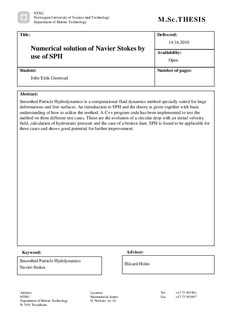| dc.description.abstract | Smoothed Particle Hydrodynamics is in many hydrodynamic problems a very suitable method, especially those with large deformations and free surfaces. Simulations of large impacts and multiphase flows may be a strong area as well. The interpolating functions are easy to implement and a SPH program does not require a huge amount of programming code to function. Though to achieve good results for more complex problems many of the simple SPH approximations should be modified. For example there have been constructed many smoothing functions and to choose there should be taken into account factors such as computational cost, numerical stability, approximation to the Dirac Delta function, differentiability, compact support and more. There are several approximations for the density such as the summation approach and continuity approach, the continuity density approach appears to be better than the summation approach due to its computational cost advantage and its applicability at free surfaces. The boundary conditions have been modelled several ways as for example boundary particles, virtual particles on the boundary and in the region boundary. Several approximations for velocity and energy have been used. Other improvement exists such as the XSPH variant which prevents particles from penetrating each other and makes particles more ordered. For simulating real fluids such as water, viscosity should be implemented. The SPH method might be a mature method, but it seems as if there still is quite much research left. It is hard to find a general common opinion or documentation of which approaches are the best. All this implies that when implementing a program based on SPH there are many factors to consider for achieving the best results and highest efficiency.
The Smoothed Particles Hydrodynamics method has been implemented to simulate three test cases. It has been shown that the evolution of the axis of a drop with an initial velocity can be approximated with only a few percent errors. The pressure at the center of the drop is however not as close to the analytical solution as desired, but shows some potential.
In addition the method’s stability and ability to reproduce hydrostatic pressure is somewhat tested by simulating a volume of water placed in a container. The pressure at a given depth is measured as the fluid reaches equilibrium. Results show a pressure which are oscillating around a value equal to the analytical pressure. The surface is calm, the pressure oscillation decreases but does not vanish and the method shows no instability in this case.
A broken dam is investigated as the last scenario. The deformation of the fluid gives an impression to be realistic. The pressure results are not given as numbers, but can to some extend be seen in the visualization. The pressure distribution shows large differences in neighboring particles, thus seem a bit off. However it is noticed that the pressure rises at important areas such as at the impact against the opposite wall.
It is found that a relatively basic implementation of the method gives approved results in terms of deformations. The results in pressure are not as great, but show potential. This implies that by some further work the SPH method has great potential in simulating suitable scenarios. | nb_NO |
